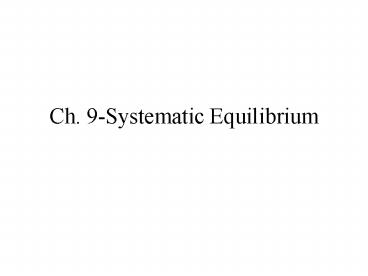Ch' 9Systematic Equilibrium PowerPoint PPT Presentation
1 / 18
Title: Ch' 9Systematic Equilibrium
1
Ch. 9-Systematic Equilibrium
2
What we Skipped
- Ch. 8 discussed Activity (?)
- This is what should be used in equilibrium
calculations rather than conc. (molarity) - In Ch. 9 in later chapters, you will occasionally
see examples mention activity and then now that
weve reminded you we will omit activity for the
rest of the chapter. - Chemistry majors will learn about activity in
P-Chem
3
Acid Rain Equilibria
Marble dissolves in acid rain by two coupled
equilibrium reactions In the real-world
chemistry is always more complex than a 1
reaction system.
4
Systematic Treatment of Equilibrium
- Systematic treatment is how the process of
dealing with chemical equilibria, no matter how
complex - There are several steps in the process
- Write equations representing chemical species
- Equilibrium conditions
- Mass and charge balance relations
- Add Approximations and Conditions which ease
calculations - Solve mulit-equation, multi-unknown system
5
Charge Balance
- Charge balance is an algebraic statement of
electroneutrality. - The sum of charges sum of - charges
- For H, OH-, K, H2PO4-, HPO42-, and PO43-
- A solution made from 0.025 mol KH2PO4 and 0.030
mol KOH in 1L
6
Charge Balance Example
- So the general form for the charge balance
- where C is the concentration of cation with
charge n and A is the concentration of an anion
with charge m - Write the charge balance for a solution with
- H2O, H, OH-, ClO4-, Fe(CN)63-, CN-, Fe3, Mg2,
CH3OH, HCN, NH3, NH4
7
Mass Balance
- Mass balance, also known as material balance is
the statement of conservation of mass - If you prepare a solution by dissolving 0.050 mol
acetic acid in 1 L water - The mass balance includes all the products. If
you put 0.025 mol phosphoric acid in 1 L H2O
8
Mass Balance Example (When Total Concentration is
Known)
- Write the mass balance for K and phosphate in
solution prepared by mixing 0.0250 mol KH2PO4
plus 0.030 mol KOH diluted to 1 L. - Potassium mass balance is easy
- For phosphate, must take dissociation into
account
9
Mass Balance Example (When Total Concentration is
Unknown)
- Write the mass balance for a saturated solution
of the slightly soluble salt Ag3PO4, which
produces Ag and phosphate in solution. - If phosphate remained as phosphate, then
- But because phosphate reacts with water, so
10
Systematic Treatment Process
- 1) Write the pertinent reactions
- 2) Write the charge balance equation
- 3) Write any mass balance equations
- 4) Write the equilibrium constant for each
reaction - 5) Count the equations and unknowns
- If equations unknowns, go to 6, otherwise
- Find other equations
- Fix concentrations at known values
- 6) Solve for all of the unknowns
11
Simple Example Water
- Apply the systematic treatment to find H and OH-
in pure water. - Step 1Write reactions
- Step 2 Charge balance
- Step 3 Mass balance
- Step 4 Equilibrium constants
- Step 5 Count, we have 2 equations and 2 unknowns
- Step 6 Solve (Youve done this already)
12
Simple Example (Solubility of Hg2Cl2)
- Apply the systematic treatment to find Hg22 in a
saturated solution of Hg2Cl2 - Step 1Write pertinent reactions
- Step 2 Charge balance
- Step 3 Mass balance
- Step 4 Equilibrium constants
13
Solubility of Hg2Cl2 Example (cont)
- Step 5 Count the equations (5) and unknowns (4)
- Equations Charge balance, 2 mass balance, 2 K
equations - Unknowns H, Hg22, Cl-, OH-
- Step 6 Solve
- Since water is not interacting with Hg2Cl2 in
this system, you can essentially solve for H and
OH- using water ionization - Of course the Hg2Cl2 equilibrium is also of
interest. We can take advantage of these to
formulas
14
Dependence of Solubility on pH
- Now we can start to deal with problems we havent
seen before.
Fluorite mineral, CaF2, is a cubic crystal
that can change colors depending on impurities
present. We will now consider the
solubility of calcium fluoride in water.
15
Solubility of CaF2 Example
- Apply the systematic treatment to find Ca2 in a
solution of CaF2. F- in solution is a weak base. - Step 1Write pertinent reactions (there are 3)
- Step 2 Charge balance (1, as always)
- Step 3 Mass balance
- Step 4 Equilibrium constants (3 of them)
16
Solubility of CaF2 (cont)
- Step 5 Count equations (5) and unknowns (5)
- Equations Charge balance, mass balance, 3 K
equations - Unknowns Ca2 (x), HF(a), F-(b), H(c),
OH-(d) - Step 6 Solve (algebraic equations)
- This is complicated! We wont go through solving
it. We will keep to 2 and 3 equation problems to
actually solve. However, you should be able to
setup the equations for these problems.
17
Solubility of CaF2 Example
- A little bit easier What if pH is fixed at 3.0?
Now solve
18
pH and Solubility
- If you do make an assumption and fix the pH
during a calculation the charge balance equation
is no longer valid. - Why?
- You would have had to add something (ions) to the
solution to fix the pH - This has not been accounted for in the balance
equation, so you cant use that during the
calculation.

